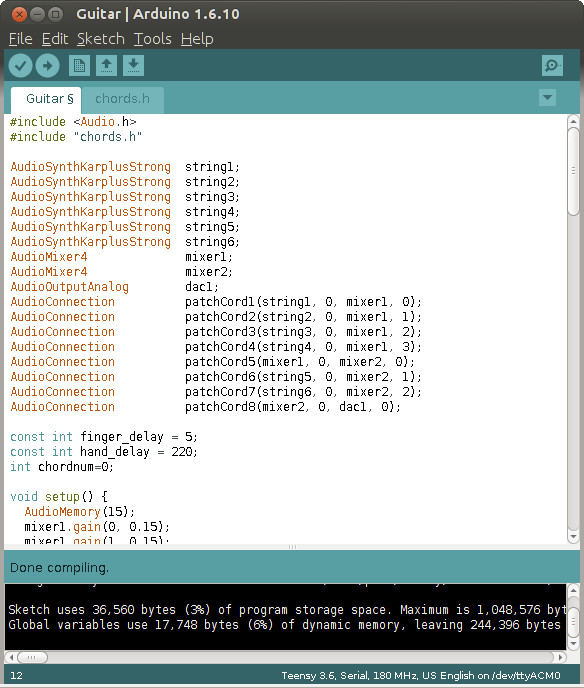Paul Stoffregen has been making Teensy USB MCU development boards since 2008, and has just launched the latest Teensy 3.5 & 3.6 boards powered by NXP (previously Freescale) Kinetis K64 & K66 ARM Cortex-M4 MCUs with a micro USB port for power and programming, a micro SD slot, and several I/Os.

Boards specifications:
- MCU
- Teensy 3.5 (T3.5) – NXP Kinetis K64 ARM Cortex M4 MCU @ 120 MHz with FPU, 512KB flash, 192 KB RAM, 4K EEPROM
- Teensy 3.6 (T3.6) – NXP Kinetis K66 ARM Cortex M4 MCU @ 180 MHz with FPU, 1MB flash, 256KB RAM, 4K EEPROM
- Storage – micro SD card port
- USB – 1x USB Full Speed (12 Mbit/sec) Port; T3.6 only: 480 Mbit/sec host port
- Connectivity – 10/100M Ethernet mac
- 62x I/O Pins (42 breadboard friendly)
- 25x Analog Inputs to 2 ADCs with 13 bits resolution
- 2x Analog Outputs (DACs) with 12 bit resolution
- 20x PWM Outputs
- 6x Serial Ports (2 with FIFO & Fast Baud Rates)
- I2S Audio Port, 4 Channel Digital Audio Input & Output
- 3x SPI Ports (1 with FIFO), 4x I2C Ports
- CAN bus – T3.5: 1x; T3.6: 2x
- 14x Hardware Timers
- General Purpose DMA channels – T3.5: 16x; T3.6: 32x
- 11x Touch sensing inputs (T3.6 only)
- Security – Cryptographic Acceleration Unit, Random Number Generator, CRC Computation Unit
- Misc – Real Time Clock; Teensy 3.5 only: 5V tolerance on all digital I/Os.
- Dimensions – N/A
The main way to developer for the board is via the Arduino IDE. You’ll find documentation and sample projects about the older boards on PJRC.com, as well as an active developer community.
The boards launched on Kickstarter yesterday, and already vastly surpassed its funding target having raised around $45,000 from 700+ backers out of a goal of $5,000. Teensy 3.5 requires a $23 pledge, while you’ll need to pledge $28 for Teensy 3.6. Shipping adds $4 to $5 to the costs, and delivery is scheduled for October 2016.
Thanks to Nanik for the tip!

Jean-Luc started CNX Software in 2010 as a part-time endeavor, before quitting his job as a software engineering manager, and starting to write daily news, and reviews full time later in 2011.
Support CNX Software! Donate via cryptocurrencies, become a Patron on Patreon, or purchase goods on Amazon or Aliexpress







I have to wonder what’s the point of this? Most of the things you’d want to do with a board of that form factor are nicely solved by the $1-$2 Arduino clones, BluePill, ESP … no need for 1MB flash just to read a temp. sensor. In the $10-$30 price range one gets a full-featured dev board with plenty of soldered headers and a GHz SoC with tons of RAM. Massively more powerful than this offering. Starting at $20-$25 one gets a quad-core SoC with 8GB eMMC on-board, a pretty case, a remote and some cables. Also known as a… Read more »
And I just got two Teensy 3.2’s! Oh well, maybe I’ll get a few more… 🙂
@Lurker
For the I/O, and/or for commercial/industrial applications. I will use the 3.6 for an application where I will use all 4 I2C ports (for interfacing with other I/O boards) and multiple serial ports for Modbus RTU messaging. The large flash makes sense for me because I can program the Modbus messaging tables in for multiple Modbus devices and switch on the fly instead of reprogramming.
@Lurker
Also this would be a great platform for FreeRTOS and the like.
@Lurker
If you checked out the Teensy web site, you’d see all of the things that it can do.
Microcontrollers can do a lot of realtime, timing-sensitive data manipulation that an application processor running a multitasking operating system would have trouble doing.
Nice, a way to work with M4’s without fighting with a user-hostile, crippled, or over-priced tool chain. This will be a welcome alternative to the STM32F4 series for some people.
There is a WARNING however:
Paul Stoffregen is known for locking you in to his “Teensy” hardware by keeping the proprietary bootloader locked up and untouchable. But if you are OK with that (many people at the “Maker” level are), then you’re good to go.
First I think the 3.5 has the 5v tolerant pins and touch sensors. It runs at 120 stock.
On the locked up boot loader he does sell a chip so you could build your own 3.1/3.2 teensy programmed with the boot loader for $6 something so you could build whatever layout you wanted with your own K20. That would help if the hardware layout was an issue and not just the cost savings. He even has a Kicad lay out available for a minimal board using the boot loader chip and a qfp K20.
@Drone Considering the bootloader is by far the most fragile and temperamental part of a system, as well as the most likely source of bricking things, his work there is exemplary honestly. And he’s happy to sell the bootloader chips for custom designs, in fact the price of those is going steadily down with the 3.2+LC bootloader chips costing less than the 3.0 bootloader chips did. I consider the <US$7/unit price for the bootloaders the cost of having access to the full Ardunio IDE and code libraries out there, as well as trivial firmware burning, versus having to fight with… Read more »